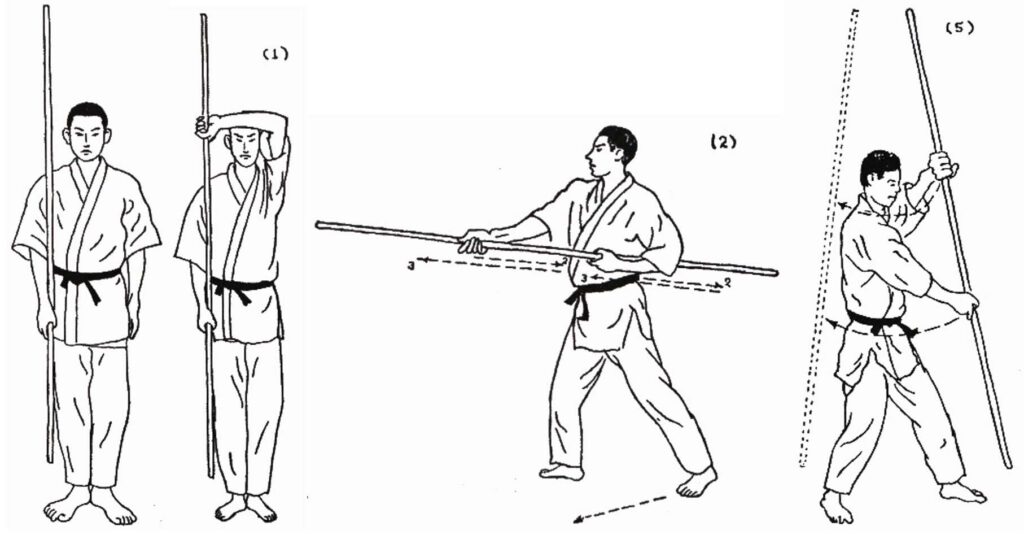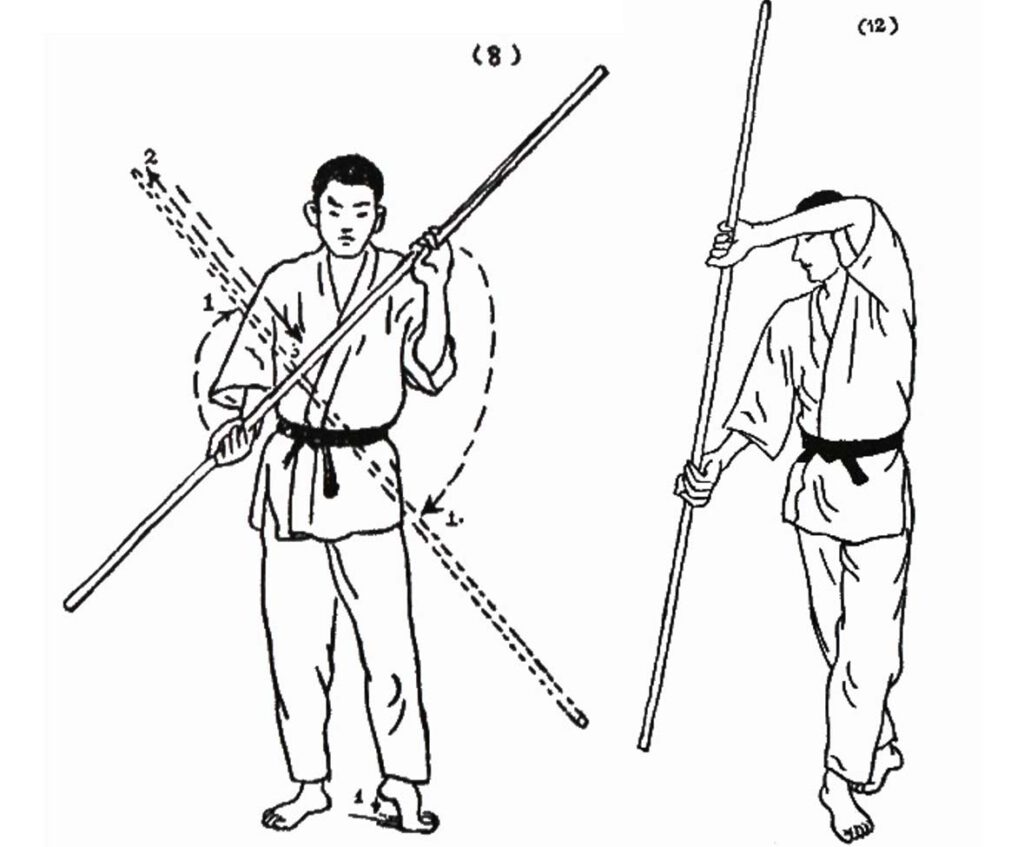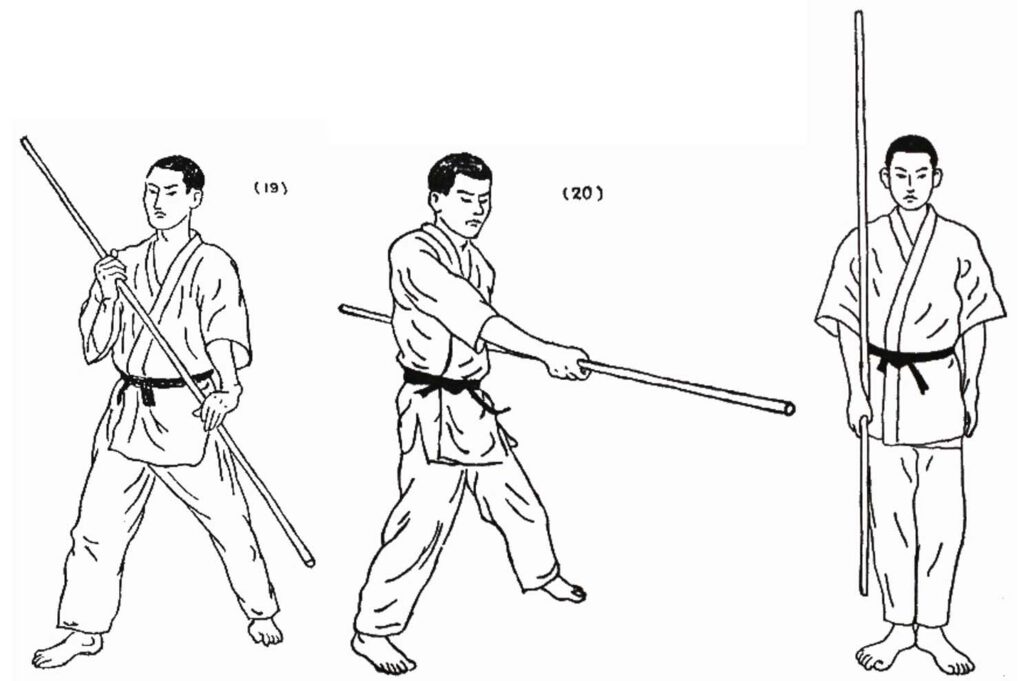This post is my 2009 translation of “Shūshi no Kon” as published in 1930 by Miki Jisaburō. Miki had learned it from Ōshiro Chōjo in 1929. I have shortened, simplified and renumbered the description to make it easier to follow and will add associated videos, shot in February 2022.
Description of Shushi no Kon (old-style)
1. Position of attention (ki o tsuke) facing direction A. Let the right arm freely hang down at the right side of your body and with the Bō parallel to the body and in contact with it.
2. Raise the left hand above your head and grip the Bō on the right side of the head (see illustration 1).
3. With the right foot remaining in its position, place the left foot backward in direction B and simultaneously strike to the front with the right end of the Bō.
4. With the right foot remaining in its position, and the grip of the hands unchanged, place the left foot forward on one line with and at about one step distance from the right foot.
5. From the previous position, thrust the Bō backward against the opponent with both hands aggressively (see illustration 2).
6. Next, thrust the Bō forward against the opponent (see illustration 2).
7. From the previous position, look and turn the body 90° counterclockwise to the left in direction C into a left Zenkutsu-dachi. In doing so, raise the left hand and lower the right hand to perform a defense to the left with the Bō (see illustration 5).
8. From the previous position, look and turn the body 180° to the right in direction D in a right Zenkutsu-dachi, and with the hands remaining in their positions perform a defense to the right side (see illustration 5).
9. From the previous position, raise the right hand to your right shoulder and from there strike to the front with your right hand.
10. Now screw (nejiru) the Bō so as to displace the opponent’s weapon.
11. From the previous position, look and turn the body 180° to the left to direction C into Neko-ashi-dachi, the left hand in front of the left shoulder, and the right hand in front of the right pelvis. From this position, step forward with the left foot into Zenkutsu-dachi and simultaneously strike down with the Bō upper left to lower right (see illustration 8).
12. Pull the right hand slanted upwards above your right shoulder, whereat the fingers of the left hand form a loose ring around the Bō. Now glide forward with both feet in direction C [left] and at the same time thrust by letting the Bō glide through the “ring” of the left fingers. (see illustration 8).
13. From the previous position turn in direction A and take one step forward to the right with the right foot. Immediately pull the left foot to the right in the position of attention (ki o tsuke) and at the same time strike to the front with the Bō.
14. Place the right foot one step forward in direction A and at the same time perform the movements from 13.
15. Place the right foot one step forward in direction A and at the same time perform the movements from 13.
16. Place the right foot one step to the right in direction F and immediately cross the left foot behind it in a cross-legged-stance. With the left hand in front of the right temple, and the right hand in front of the right pelvis, perform a defense to the right side in direction F (see illustration 12).
17. Detach the left foot and place it one step backwards into direction E and at the same time pull the right hand back to the right shoulder. Now step forward with the right foot into a right Zenkutsu-dachi in direction F and strike down to the front in direction F. Finally, perform the screw defense (nejiru).
18. From the previous position, look and turn the body 180° counterclockwise in direction E, with a lower block.
19. With the left foot remaining in its position, place the right foot forward in front of the left foot, and attach the left foot behind it a cross-legged-stance, and perform a vertical block in direction E.
20. From the previous position, place the left foot backward so as to assume a right Zenkutsu-dachi, and simultaneously raise the Bō to your right shoulder, and strike to the front. Finish with the screw defense (nejiru).
21. With your right foot as the pivot, place your left foot forward to the left, in direction B, and turn 90° clockwise to the right, and simultaneously perform a defense [mamoru: Tate-uke] to the front.
22. After the defense (mamoru) with the Bō to the front, pull back the right foot a little bit and cross it with the left foot to the front. Next, with the left foot remaining in place, step forward with the right foot, into right Zenkutsu-dachi, and perform a defense (mamoru = tate-uke) to the front.
23. Raise the Bō and from the upper right strike Shōmen-uchi downwards to the front in direction A, followed by nejiru-uke.
24. Next push out the left hand to the front and downwards, and thus perform a sweeping strike (uchiharai) down to the left [see Illustration 19] with both feet remaining in Zenkutsu-ashi-dachi [it is a preparation for the winding block].
25. With the left foot remaining in its position, cross the right foot in front of the left [to the left in direction B]. Then detach the left foot and place it one step [to the left] in direction B into Naihanchi-dachi. The body is aligned sideways, the eyes however look in direction A. Perform a strike with the Bō parallel to the ground and to the side (yoko uchi) [perform the yoko-uchi with winding action starting from illustration 19!].
26. With the left foot remaining in position, pull the right foot towards the left foot into Musubi-dachi and align the body towards direction A, as shown in picture No. 1 of the Kata. Next, let go of the Bō with your left hand and place it at your thigh, thus reassuming the starting position.
End
© 2022, Andreas Quast. All rights reserved.



